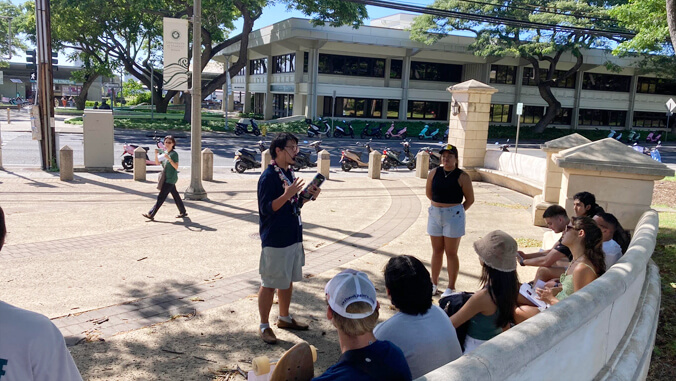

A powerful campus tour at the University of Hawaiʻi at Mānoa is encouraging students, faculty and visitors to look at the ʻāina beneath them with fresh eyesʻand deeper understanding.
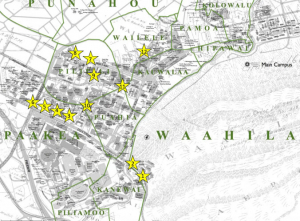
The tour, Remapping UH Mānoa: A Campus Huakaʻi, is more than just a walk through campus—it’s an immersive experience that brings to light the layered, often overlooked, stories of the ʻili ʻāina, or traditional land divisions, that make up the valley of Mānoa. Participants explore not only Hawaiian geography and ʻōlelo Hawaiʻi (Hawaiian language), but also untold histories of displacement, resilience and renewal.
“The hope is to recognize the uniqueness of our location, and to feel welcome to learn more about that together,” said Christina Higgins, professor of Second Language Studies (SLS) and one of the tour’s co-creators. “It’s really an invitation to lean into the unique history and opportunities to learn in Hawaiʻi together.”
The project is sponsored by the UH Mānoa Native Hawaiian Place of Learning Advancement Office and the Multilingual Multicultural Initiative.
ʻIke Hawaiʻi center, Lunalilo lands
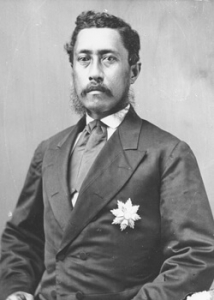
The tour begins in the ʻili ʻāina of Kānewai at the Kamakakūokalani Center for Hawaiian Studies—one of the few buildings on campus named in honor of a kanaka ʻōiwi (Native Hawaiian). The center stands as a tribute to the legacy of Native Hawaiian educator Gladys Kamakakūokalani ʻAinoa Brandt, and the decades-long effort to elevate Hawaiian ʻike (knowledge) and language within higher education.
From there, the huakaʻi continues through Paʻakea, the land division where Legacy Path and Andrews Amphitheatre now sit. This section of ʻāina was once owned by King William Lunalilo. The land was known for its fresh water springs and kalo patches. Later, Chinese and Japanese families cultivated rice and raised ducks and chickens here. Participants also venture to the area fronting Bachman Hall where ahu stand. Among them is a stone altar built in 2006 to remind UH leadership of their responsibility to mālama Hāloa.
Founder’s gate, Saunders Hall
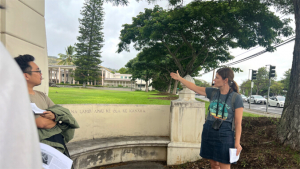
The next stop is at Founder’s Gate, at the intersection of University Avenue and Dole Street. On the concrete bench is the University motto, and is one of the few places on campus where ʻōlelo Hawaiʻi can be found. It reads, “Maluna aʻe o nā lāhui a pau ke ola ke kanaka” (Above all nations is humanity). Rather than expressing a Hawaiian perspective, these words were simply translated from the motto of Cornell University, a land-grant university that served as a blueprint for UH Mānoa. Participants are invited to reflect on where the Hawaiian language is seen and heard on campus, and to imagine spaces where it could be more prominent.
In the Pilipili land division, Saunders Hall is another stop with a painful past. Once named after psychologist Stanley Porteus, who promoted eugenics, the building was renamed in 1998 after students and faculty pushed back. It now honors Allan Saunders, a champion of civil rights and political science education.
Remembering Hawaiʻi leaders
Stories of strength also emerge. Fronting Bachman Hall, John Henry Wise lawn honors the former Native Hawaiian senator and language advocate who helped pass the Hawaiian Homes Commission Act in 1921.
Campus eatery hotspot, Paradise Palms is located within the ʻili ʻāina of Wailele where participants learn about Chief Boki and the legacy of the Beckley family—including Frederick William Kahapula Beckley Jr., the university’s first ʻōlelo Hawaiʻi instructor, and his mother, Emma Metcalf Beckley Nakuina, a judge, water rights expert, and author of Hawaiian history.
“This tour is so great because it invites folx to get curious about their spaces and thus to get curious about themselves: what is the story of this place? This tree? This rain? What are their names? What are the stories that I bring? That my peers bring?” said Punihei Lipe, director of Ka Papa O Ke Ao Native Hawaiian Learning Advancement Office. “This is the work of exploring and getting to know the many genealogies that shape our campus and to do so is very reflective of Hawaiʻi.”
From left: Chief Boki (Credit: John Hayter – National Library of New Zealand), Emma Metcalf Beckley Nakuina (Credit: Hawaiʻi State Archives)
Decolonizing through dialogue

The campus huakaʻi (journey) inspired former UH Mānoa doctoral student Ha Nguyen to write her dissertation on how students responded to the tour. Nguyen earned a PhD in SLS and graduated in fall 2024. Her research, co-authored with Higgins and Lipe, which was recently published in the Journal of Higher Education, found that participants began reflecting deeply on colonization and developing a deeper interest in the histories of Hawaiʻi, their homelands and other ʻāina.
Guided by ʻāina
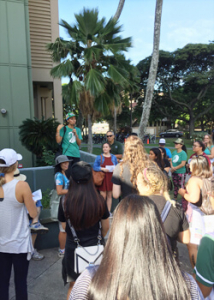
To build on this momentum, Higgins and her team proposed multilingual wayfinding signs and a campus timeline in 2018 to highlight the multicultural and Indigenous history of UH Mānoa. At present, two signs have been added to campus that feature the ʻili ʻāina names of Pilipili (Bilger) and Kauwalaʻa (Life Sciences). Recognizing these ʻili ʻāina creates an opportunity to learn about the Hawaiian principle of kuleana through reflecting on the interdependence of land, water, nature and people in Mānoa.
The signs await further details that could allow passersby to learn about the meanings and the land that is now UH Mānoa. These efforts aim to map kuleana, connect campus areas to their traditional ʻili ʻāina, and support UH Mānoa as it strives to become a Hawaiian place of learning.
In 2022, UH Mānoa received a full 10-year reaffirmation of accreditation from the Senior College & University Commission of the Western Association of Schools and Colleges or WASC. The commission praised the university’s continued efforts to develop wayfinding signage that honors its identity as a Native Hawaiian Place of Learning, recognizing the project as a meaningful step in grounding the campus in place, language and culture.
“My hope is that we’ll have more opportunities to design signage that celebrates ʻike Hawaiʻi and helps all who step on campus understand the stories of this place and connect people more deeply to the ʻāina and its history,” said Higgins.
The campus huakaʻi tour is conducted by faculty and students and is offered by request.
For more information go to the Remapping UH Mānoa: A Campus Huakaʻi website.

